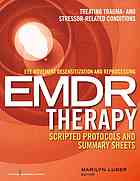

Most ebook files are in PDF format, so you can easily read them using various software such as Foxit Reader or directly on the Google Chrome browser.
Some ebook files are released by publishers in other formats such as .awz, .mobi, .epub, .fb2, etc. You may need to install specific software to read these formats on mobile/PC, such as Calibre.
Please read the tutorial at this link: https://ebookbell.com/faq
We offer FREE conversion to the popular formats you request; however, this may take some time. Therefore, right after payment, please email us, and we will try to provide the service as quickly as possible.
For some exceptional file formats or broken links (if any), please refrain from opening any disputes. Instead, email us first, and we will try to assist within a maximum of 6 hours.
EbookBell Team

0.0
0 reviewsEMDR Therapy is a psychotherapy approach based on standard procedures and protocols. Using EMDR Thera's standard procedures and protocols as its template, this book presents step-by-step scripts that enable new practitioners and seasoned EMDR clinicians, trainers, and consultants alike to incorporate EMDR Therapy into their case conceptualizations and treatment plans while working with patients who have issues related to trauma- and stressor-related conditions. These scripts can be put to use immediately and retain the complete integrity of EMDR Therapy by presenting the three-prong protocol (past memories, present triggers, and future templates) and the 11-step procedure essential to the standard practice of EMDR Therapy. They reinforce the specific parts, sequence, and language used to create an effective outcome, and illustrate how clinicians are using this framework to work with a variety of therapeutic difficulties and modalities while maintaining the integrity of the Adaptive Information Processing (AIP) model.
This text covers the use of EMDR Therapy with such conditions as reactive attachment disorder, PTSD, acute stress disorder, and persistent complex bereavement disorder, as well as with traumatized patients with psychosis, trauma in emergency (911) telecommunicators, and compassion fatigue. Scripts and summary sheets simplify the gathering of information and ensure documentation in clients' charts in a consistent format. This facilitates quick retrieval of the essential issues and components needed by clinicians to create appropriate treatment plans and easy access to client information.
Key Features: